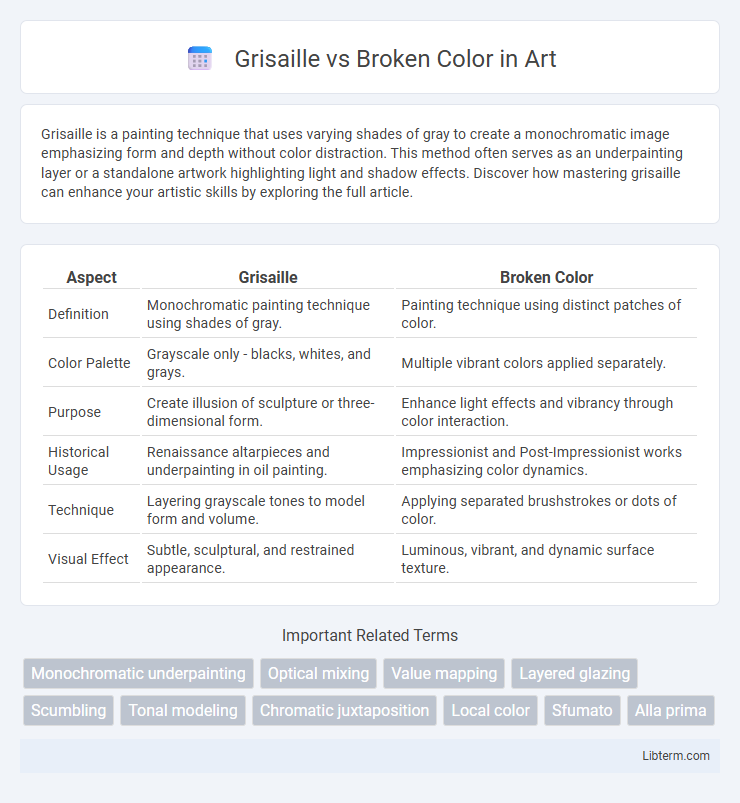Grisaille is a painting technique that uses varying shades of gray to create a monochromatic image emphasizing form and depth without color distraction. This method often serves as an underpainting layer or a standalone artwork highlighting light and shadow effects. Discover how mastering grisaille can enhance your artistic skills by exploring the full article.
Table of Comparison
| Aspect | Grisaille | Broken Color |
|---|---|---|
| Definition | Monochromatic painting technique using shades of gray. | Painting technique using distinct patches of color. |
| Color Palette | Grayscale only - blacks, whites, and grays. | Multiple vibrant colors applied separately. |
| Purpose | Create illusion of sculpture or three-dimensional form. | Enhance light effects and vibrancy through color interaction. |
| Historical Usage | Renaissance altarpieces and underpainting in oil painting. | Impressionist and Post-Impressionist works emphasizing color dynamics. |
| Technique | Layering grayscale tones to model form and volume. | Applying separated brushstrokes or dots of color. |
| Visual Effect | Subtle, sculptural, and restrained appearance. | Luminous, vibrant, and dynamic surface texture. |
Introduction to Grisaille and Broken Color
Grisaille is a painting technique that uses varying shades of gray to create a monochromatic, sculptural effect often employed for underpaintings or standalone artworks. Broken Color involves applying distinct, separated patches of pure color to allow optical blending, enhancing vibrancy and texture typical in Impressionist works. Both methods emphasize different approaches to color and light, with Grisaille focusing on tonal values and Broken Color on color perception.
Historical Origins and Evolution
Grisaille, originating in the 14th century as a monochromatic painting technique using shades of gray, evolved primarily within Gothic and Renaissance art to mimic sculpture and enhance architectural elements. Broken Color, emerging in the 19th century with the Impressionists, uses fragmented strokes of pure color to capture light and vibrancy, contrasting with the smooth tonal transitions of Grisaille. The evolution of Grisaille reflects its role in religious and classical art, while Broken Color represents modern explorations in color perception and optical mixing.
Defining Grisaille: Techniques and Aesthetics
Grisaille is a painting technique executed entirely in shades of gray, designed to simulate sculpture or create a monochromatic underpainting that emphasizes form and volume. This method uses a limited palette to build depth through tonal contrasts, often serving as a foundational layer before applying color, which enhances the structural clarity of the artwork. Its aesthetics rely on subtle gradations and precise brushwork, generating a sculptural effect distinct from the vivid textures and fragmented brushstrokes characteristic of Broken Color.
Understanding Broken Color: Methods and Visual Effects
Broken color employs short, distinct brushstrokes of pure hues applied side by side, creating a vibrant, shimmering surface that captures light and movement. This technique contrasts with grisaille, which uses monochromatic shades of gray to establish tonal values and form through a restrained palette. Understanding broken color's layering methods enhances appreciation of its ability to evoke luminosity and dynamic texture in paintings.
Key Differences Between Grisaille and Broken Color
Grisaille is a monochromatic painting technique using shades of gray to create a sculptural, tonal effect, primarily emphasizing form and volume without color distractions. Broken Color involves applying small, distinct patches of pure color side by side, allowing the viewer's eye to blend them for a vibrant, dynamic effect emphasizing color interaction and texture. The key difference lies in Grisaille's focus on tonal gradation and form in grayscale versus Broken Color's emphasis on color contrast and optical blending.
Famous Artists and Works in Grisaille
Grisaille, a monochromatic painting technique using shades of gray, was famously employed by artists like Jan van Eyck in the Ghent Altarpiece and Albrecht Durer in his engravings, emphasizing volume and detail. This method contrasts with broken color, which uses distinct color dabs for vibrancy, as seen in Impressionist works by Claude Monet and Georges Seurat. Grisaille's historical significance lies in its use for underpaintings and standalone works that highlight form through tonal values rather than color variation.
Notable Paintings Utilizing Broken Color
Notable paintings utilizing broken color include Claude Monet's "Impression, Sunrise" and Vincent van Gogh's "Starry Night," where artists apply small, distinct brush strokes of pure color to create vibrant visual effects and dynamic light interplay. This technique contrasts with grisaille, which uses monochromatic tones to emphasize form and shading rather than color vibrancy. Broken color enhances texture and movement, making it a hallmark of Impressionism and Post-Impressionism.
Applications in Contemporary Art Practices
Grisaille, a monochromatic painting technique using shades of gray, enhances depth and form in contemporary portraiture and figurative art by emphasizing structure without color distractions. Broken color applies fragmented brushstrokes of pure hues that blend optically, widely used in modern impressionist and abstract works to create vibrant texture and dynamic light effects. Both techniques influence mixed media practices, allowing artists to explore contrasts between subtle tonal gradations and vivid chromatic interplay in innovative visual narratives.
Advantages and Limitations of Each Technique
Grisaille offers precise control over tonal values and is ideal for creating detailed underpaintings that enhance depth and structure, but it can result in a monochromatic and less vibrant final appearance. Broken color allows artists to achieve vibrant, shimmering effects by applying small strokes of pure color that mix optically, enhancing luminosity and texture; however, this technique can lack fine detail and may appear less controlled. Both techniques serve distinct purposes: grisaille excels in tonal foundation and form definition, while broken color prioritizes color intensity and dynamic surface effects.
Choosing Between Grisaille and Broken Color: Artistic Considerations
Choosing between grisaille and broken color depends on the desired artistic effect and emotional impact. Grisaille emphasizes tonal values and monochromatic subtlety, making it ideal for studies, underpaintings, or dramatic, sculptural compositions. Broken color uses separate patches of pure pigment to create vibrant optical mixing and texture, preferred for lively, impressionistic works and rich surface complexity.
Grisaille Infographic

 libterm.com
libterm.com